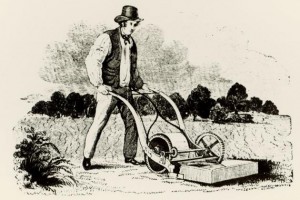The first lawn mower was invented in 1830 by Edwin Beard Budding, who also invented the adjustable spanner in

Thank you for reading this post, don't forget to subscribe!
The first lawn mower used the cylinder technology that had so inspired Beard, and which is still used today for manual cylinder lawn mowers. Mounted on a wrought iron frame, the cutting cylinder was driven by gears attached to the rear roller, while another roller could be inserted between the two to alter the cutting height. The clippings were collected in a box at the front of the mower. These early machines were heavy, and it wasn’t long before another handle was mounted at the front to help pull the mower along.
Initially the early cylinder lawn mowers were used to replace the traditional scythe on ornamental lawns and sports grounds, as the finer finish made a big difference to the sport being played and actually contributed to the formalising of rules for sports such as lawn bowls and tennis. Scythes were still routinely used by rural people who did not have the money for a lawn mower, as well as agricultural workers who had been mowing the traditional way for centuries. Certainly, the scythe was much faster over a large expanse and as a scythe was much cheaper to buy and maintain than an early cylinder lawn mower it was much more cost effective for a team to mow a meadow the old way.
The first two Budding machines were bought by Regent’s Park Zoological Gardens and some Oxford Colleges to keep the public areas looking pristine. Budding was not working alone, however. A man named John Ferrabee was involved financially, securing the rights to manufacture and license the technology to other manufacturers as well as providing the funding to enlarge the cutting blades to improve performance. The pair also manufactured the original design in Thrupp, Gloucestershire, which is just down the road from our shop!

The 1860s saw the lawn mower enter mass production as demand rose, and in 1862 Ferrabee was producing over 5000 machines in eight styles. By 1893 steam technology had intersected with grass cutting technology and James Sumner patented the first steam powered lawn mower. Forty years later combustion engine technology had advanced to the point where an engine could be small and powerful enough to be mounted to a lawn mower, and the more advanced (and more efficient) rotary blade mowers became a possibility. By the late 1950s rotary mowers were mass-produced and available to everyone.
The last ten years have seen even more technological advances and now it is possible to mow the lawn without even being at home thanks to robot mowers, but there are still some people who prefer the traditional scythe. This old technology is making a comeback, mostly thanks to Aidan Turner in Poldark, whose shirtless scything sparked a lot of debate about proper technique as well as a resurgence of the desire to learn this long-lost skill. If Budding were alive today we can only imagine whether he would approve of bringing back the scythe or whether he would favour the manless mower!
